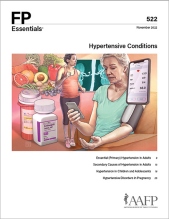
This clinical content conforms to AAFP criteria for CME.
Hypertensive disorders in pregnancy (HDP) represent a spectrum of disease that affect women through pregnancy and the immediate postpartum period. These conditions are associated with significant morbidity and mortality during and after pregnancy and have been linked to cardiovascular disease later in life. The HDP spectrum includes gestational hypertension (HTN), preeclampsia, eclampsia, HELLP (hemolysis, elevated liver enzymes, and low platelet count) syndrome, chronic HTN, and chronic HTN with superimposed preeclampsia. Low-dose aspirin is recommended as a preventive drug after 12 weeks’ gestation in women who are at high risk of preeclampsia. In HDP, close blood pressure (BP) monitoring, laboratory evaluation, and fetal assessment are warranted. Labetalol and nifedipine extended release are first-line oral antihypertensives for outpatient BP management of chronic HTN; labetalol, hydralazine, and nifedipine immediate release are used for hospitalized patients. HDP may develop or progress in the postpartum period; continued vigilance is important in the puerperium.
Case 4. LL is a 27-year-old patient, gravida 1, at 32 weeks’ and 5 days’ gestation. You are seeing her for the first time after she and her husband transferred from overseas, where her husband had been stationed. You review her records and note that her pregnancy has been uncomplicated thus far. Today, her blood pressure (BP) is 140/88 mm Hg. She reports feeling fine and states that this is “exactly what happened to her sister.” She is concerned and wants to know what she should do next.
Subscribe
From $350- Immediate, unlimited access to FP Essentials content
- 60 CME credits/year
- AAFP app access
- Print delivery available
Edition Access
$44- Immediate, unlimited access to this edition's content
- 5 CME credits
- AAFP app access
- Print delivery available
